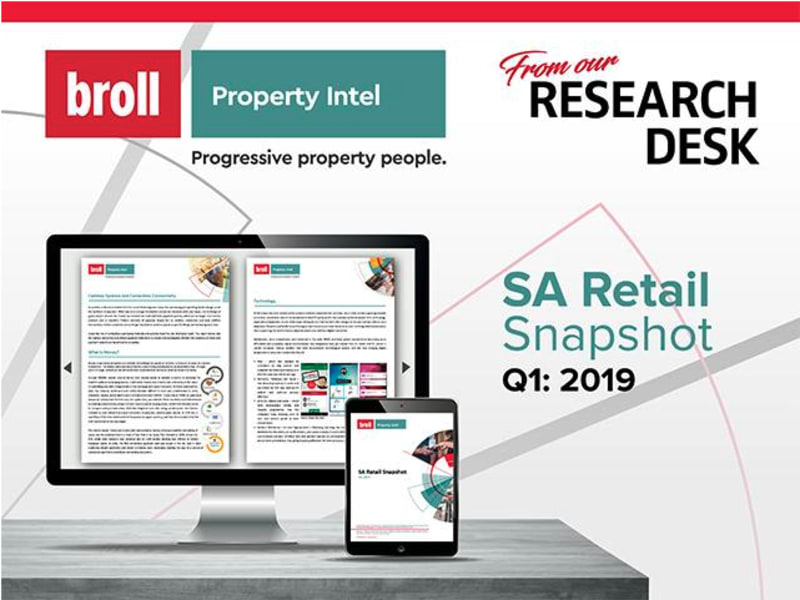To Let
Search
Latest News
Back to news results

Broll's latest SA Retail Snapshot puts the spotlight on cashless payment systems
Shopper spending habits and how consumers purchase goods and services have changed significantly especially over the last few decades with the advent of cashless payment systems and contactless connectivity.
The biggest driver of this has been technology and the retail sector has been largely receptive of this, evolving and keeping pace with new digital technologies and consequent changes in consumer shopping behaviour.
In light of these changes, Broll Property Group's quarterly SA Retail Snapshot Report (Q1: 2019) investigates Cashless Systems and Contactless Connectivity. The latest report was published in May by Broll Property Intel, which is the research division of leading Pan-African commercial property services group, Broll.
Elaine Wilson, Director of Broll Property Intel, comments: "The report gives some progressive insight into what's happening in the cashless and digital payments space globally and looks at how some South African retailers and banks are embracing these changes. However, we also question whether the existence of these new payment systems is beneficial for all parties?"
The 12-page report first takes a brief look at the origins of "flat money" (coins and paper money) and later other payments systems such as "representative money" (cheques) and credit cards. It then zones into changes in the last 20 years with mobile banking, contactless payments cards; and, more recently, how mobile payment systems and virtual currencies have been developed on the back of the smartphone tech revolution.
Broll Property Intel's researchers query in the report: "If flat money has been utilised as the primary method of payment for centuries, why is that society is gearing towards a cashless, contactless culture?"
As mentioned in The Evolution of Retail Report 2019, Broll notes that technology, especially around smartphones, is one of the major driving forces that has led to the changes in the way humans interact on a daily basis.
The latest SA Retail Snapshot Report, reiterates: "Retailers and landlords are having to take into account these factors in an ever-evolving retail environment, thus supporting the need to have a physical presence as well as a digital connection. Additionally, since smartphones were invented in the early 2010's and have gained popularity by becoming more affordable and accessible, digital transformation and integration have permeated lives for better and for worse in certain instances. Various retailers have incorporated technological aspects and are thus bringing digital integration to consumers."
The report highlights some of the digital integration innovations that both international and local South African retail brands have introduced, through smartphone apps and other instore technologies to improve the shopping experience.
For example, the report notes that Builders Warehouse's new flagship store in Boksburg, Gauteng, has incorporated various technology-driven elements into the store such as 3D printers, pool water analysis, in-store online shopping touch screens and mobile scan-and-pay scanners. "All these tech and payment options are anticipated to enhance the shopping experience and provide convenience, thus giving instant gratification for time-conscious customers," it adds.
Cellphone and Digital Banking making waves
In terms of mobile or cellphone banking, Broll's researchers examined how USSD (Unstructured Supplementary Service Data) mobile communication technology was the forerunner to cellphone banking as we know it today. In its report, Broll highlights Kenya's highly successful m-pesa mobile money system, which was launched off USSD technology for ordinary cellphones, before the arrival of smartphones.
With new digital banks making waves in the South African market, the report also highlights some of the new players such as TymeBank and Discovery Bank. In addition, it zones into various contactless payment offerings such as Tap-and-Go; e-wallets; smartphone-specific contactless payment options such as Apple Pay and Samsung Pay; wearable devices and apps, such as Fitbit and Fitbit Pay; QR code options like Standard Bank's SnapScan and Alibaba's AliPay; as well as biometric and voice-enabled payment systems.
Contactless Payment and Wearables
"Most credit cards and debit cards nowadays have an embedded microchip. When in close proximity, the microchip exchanges payment details that are safely and securely transmitted, making payment interactions/transactions contactless with use of RFID (Radio Frequency Identification) technology," notes the report.
"RFID technology has many perks, which allows for the embedding of microchips into almost anything, such as clothing (Lyle & Scott and Barclaycard's world-first contactless payment jacket) and accessories (payment sunglasses and the world's first contactless payment ring - K Ring). Contactless payment methods colloquially known as Tap-to-Pay, Tap-and-Go or just Tap, enables for quick, secure and convenient transactions, all while one's card remains safely in their possession," it explains.
The technology has seen smart devices becoming increasingly popular, with the tech enhancements in such devices and so-called wearables providing owners with a practical, multi-functional daily tool. "Synchronised with a corresponding app or software, where a user's credit card and/or debit card credentials are securely stored, these wearables allow for seamless and more importantly cardless payments," notes the report.
Disadvantages of contactless payments
Broll's report also zones into some of the disadvantages of contactless payments.
"While technology has amplified convenience and efficiency in stores and restaurants globally, some countries and cities such as Philadelphia and New Jersey have already banned retailers from accepting and implementing cashless-payments-only systems," notes the report.
Wilson comments: "Our latest SA Retail Snapshot Report (Q1: 2019) provides in-depth insight on the impact of cashless payment systems in today's ever-evolving world and how its users have utilised the multitude of contactless payment platforms, and where retailers and landlords are having to adapt and embrace the new technologies."
The full report is readily available at www.broll.com/publications